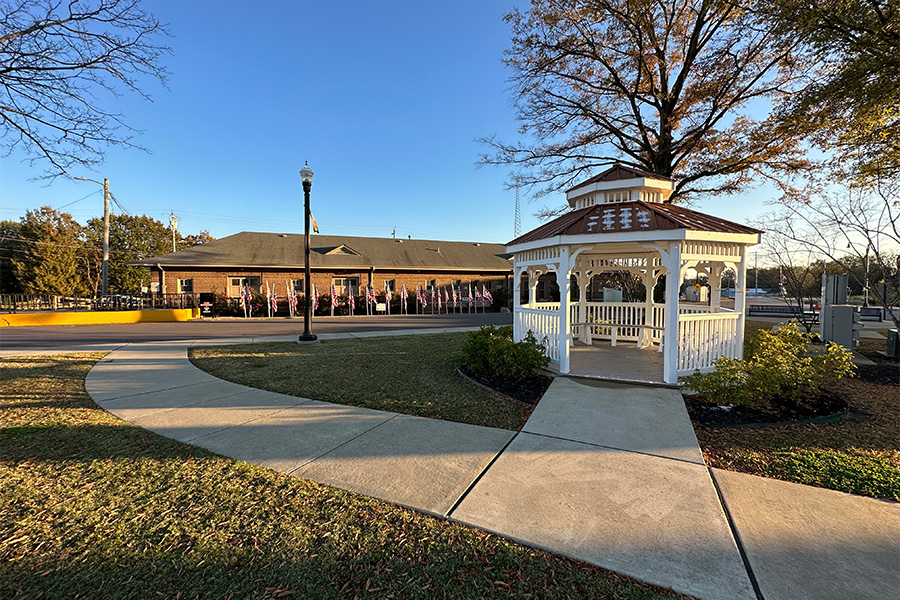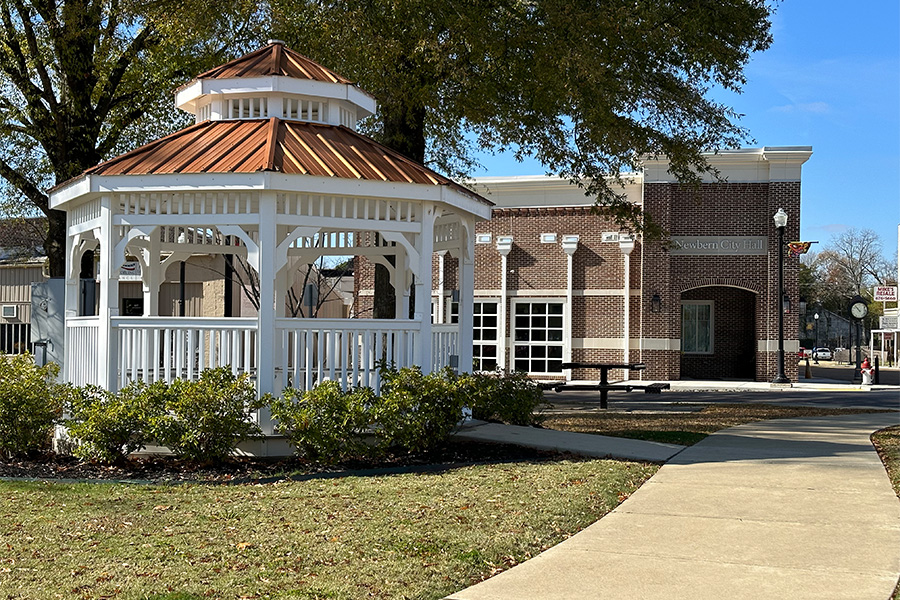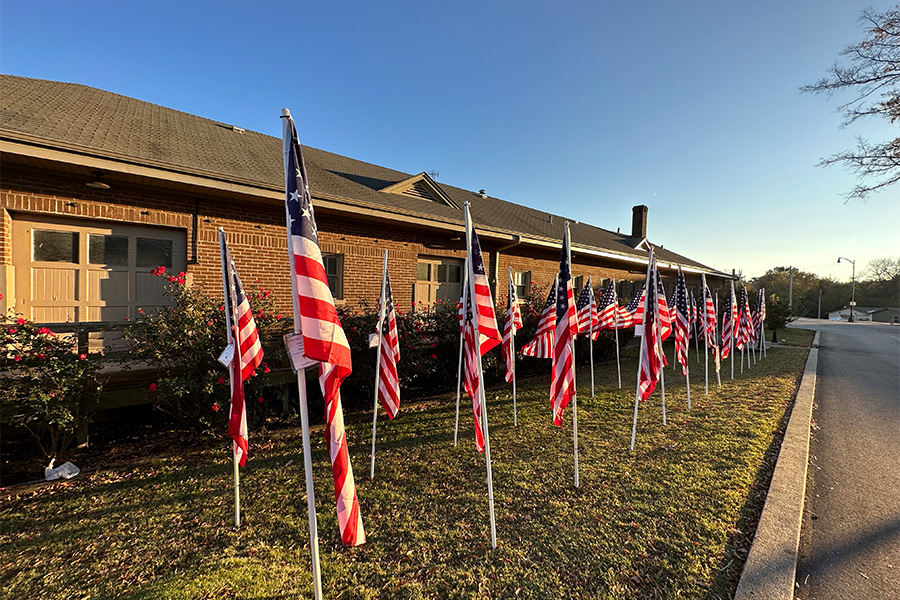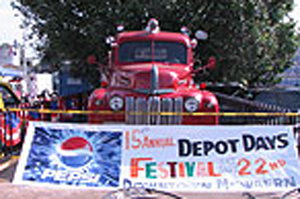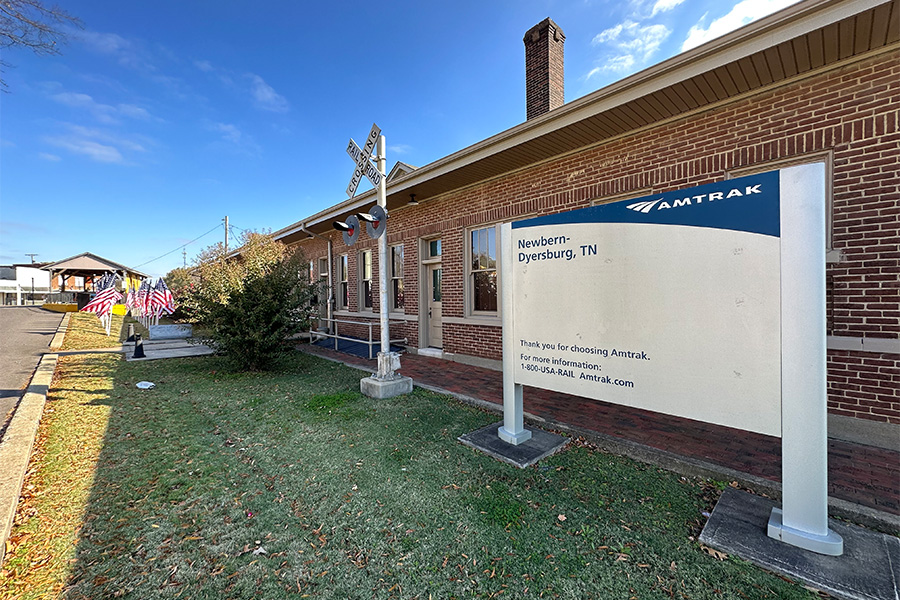Newbern History

This following history was hand-dated November 1955, written by Ms. Eugenia Ellis (Jetton), and published in the Newbern Tennessean newspaper.
According to the article, Ms. Ellis was a Home Economics student, with a focus on Journalism, at the University of Tennessee in Martin, Tennessee. Her professor and guidance in creating this article was noted author Harry Harrison Kroll. It has since been updated by the Newbern Historical Society.
"The history of a town is united with that of the country to which it belongs and that with the ages through which it has stood." -Eugenia Ellis Jetton
Newbern Tennessee was pioneered by our forefathers many years ago. A surge propelled them to embark in search of new lands in the newly claimed Indian Country after the Removal Act of 1830. They traveled by covered wagon, on horseback and on foot over the rugged mountain trails from our mother state of North Carolina to Western Tennessee.
In 1844 [sic] the Reverend Hamilton Parks, who organized the first six Cumberland Presbyterian Churches in this section [Dyer County], settled about one and a half miles Northeast of Newbern on what is now the Bryant Easley Farm.
He brought a family named Philley with him from New Bern, North Carolina. The Philley family staked a claim where the principle [sic] part of Newbern now stands. Mr. Owen Philley built a log house on the land that was originally possessed by the Chickasaw Indians. This area was originally used as a native American hunting ground. Shortly after [sic] the [Philleys] constructed their home several other families followed.
Around the year [sic] 1849-1850 [sic] John McSpaddin built the first general store when the town was just a strip of woods. Mr. Thosmas McSpaddin and his brother [sic] John [sic] constructed the first business house in the fall of 1851. It was a small log structure on the [s]outh side of Main Street, in what is now the public square. It was constructed by the family and used as a store for dry goods, groceries and general merchandise.
In the spring of 1852 [sic] C.E. White [sic] of Trenton [sic] bought out Mr. McSpaddin and his stock of goods, then moving to Newbern in that same year. Quincy Roarch and Hiram McCorkle built a house on the [n]orth side of Main Street and commenced selling dry goods in the business district.
Mr. Jessie Franklin Williamson arrived in Newbern in 1854 with his wife [sic] Sara [sic] and six children from Statesville, North Carolina. Mr. Williamson was a cabinet maker and coffin builder. He kept seasoned walnut lumber and made a coffin when there was a death, according to your size. Many times [sic] those living a good distance away, [sic] would come with the necessary measurement [sic] and Mr. Williamson would spend the entire night making the coffin. His wife would then line the coffin with fine linin [sic] and cloth. The persons would spend the night in the Williamson’s home and return to their respective place with the coffin the next morning.
At this time (1854) [sic] there were two dry goods stores, a blacksmith, one saddle shop and Mr. Williamson’s cabinet and coffin shop. The Mail Route came from Dresden to Yorkville, then to Newbern and continuing on to Dyersburg. The mail was delivered on an old blazed-faced sorrel horse. Mail was delivered to the local post office, [sic] once a week in each of these three towns. If weather was not permissible to travel, it did not arrive until some indefinite period of time afterward.
In 1855, Mr. G.D. Tinsley bought the old Philley’s place and commence[d] the family grocery business on the corner, known afterwards as Tinsley’s Corner according to railroad documents. Mr. Tinsley built the first hotel in 1856. [What remains of Tinsley’s Corner today is where Washington Street makes the sharp curve from West Main Street going north. It would have included the area roughly between West Main and Moore’s Alley, from the Hardware Store to Washington Street, about a half acre. At that time, it would have been a little larger.]
The pioneers realized their spiritual need and buil[t] and organized the Cumberland Presbyterian Church a[t] Poplar Grove about one and a quarter miles [n]ortheast of town and the Methodist Church at Church Grove about two miles [s]outhwest of town. These two church cemeteries became the internment areas for local residence. The Baptist Church was located about three miles [e]ast of town near the Atkins neighborhood.
The early schools were taught at these two churches.
Following eight years of progress [sic] some of the men decided the village needed a name. Since many of the families were from North Carolina, Mr. Philley had originally donated 100 acres for this purpose. Among the men, they decided to name the town near Mr. Philley’s birthplace of New Bern [sic] North Carolina. This name [had] originated from the town of the same name in Switzerland. It was named for the News River and the town Bern. Thus the small pioneer town received the name New Bern.
In 1857 [sic] the citizens then wrote to the state capitol petitioning the state government for the privilege of establishing a town. In those days the dispatch or mail was exceeding [sic] slow. In [sic] about a month after [sic] settlers received a letter from Nashville, sic] stating that their letter had been received,[sic] but they had failed to mention the name of the town they were establishing. The document was returned with the name [sic] and Newbern was incorporated in 1858. [When the capitol sent the papers back, the city name was written as Newbern, instead of New Bern New Bern.]
The first school house built was the Newbern Academy, [sic] for the purpose of educating the children of the town and the surrounding area. It was revealed in a letter found between two boards of a table built by Mr. Clay Porter that Mr. W. J. Anderson was the first teacher of the Newbern Academy. The first session commence[d] the 20th day of September in 1858. For teaching at the academ [sic] the Presbyterian minister received three hundred dollars a year.
The Newbern Academy was built with public subscriptions. It was a wooden structure consisting of two stories, [with] the expense of erecting the first story being paid from subscription funds [sic] and the second story used as a lodge hall was financed by the Odd Fellows and the Masonic Lodge. Two Ballard brothers succeeded Mr. Anderson as teachers of the Academy. He enlisted in the Southern Army at the outbreak of the Civil Ware [sic] and was killed during the conflict. The Newbern Academy was located on South Monroe Street at the top of the hill behind the Methodist Church.
The attached photo shows the Odd Fellows in 1885. The location is unknown.
At this time, Newbern was a small town [sic] but things were looking up. Intemperance was at a high point and the state of morals not enviable by any section. At this time there were two merchandise stores, one grocery store, two cabinet makers, one wagon maker, a blacksmith shop, one bricklayer and one shoemaker. Land was selling for between 28-30 dollars per acre.
In the early days of Newbern [sic] the closet market for farm crops, [sic] was Hickman [sic] Kentucky which was known as the St. Louis of the South. The long treacherous journey was made over undeveloped roads. After the Civil War [sic] these roads were very dangerous due to the remaining Bushwhackers and Jayhawkers.
In 1860 [sic] Dr. J.R. Westbrook, a distinguished physician, moved to Newbern. He was associated with Walker and Company who was in the Drug Business. He bought land and a house that Mr. W.J. Anderson bought from Mr. Elijah Fuller and [that] became known as the Westbrook Home located at 109 South Jackson Avenue. This lot extended east to the Academy [l]ot and to the [n]orth on Main Street. The home was known as “Idlewild”. [The house is still standing and is one of the oldest homes in Newber, if not the oldest. Up until about 25 years ago, there was ivy that grew on the chimney of the house. The legend was that the ivy came from Mt. Vernon, the home of George Washington.]
The Sunday School and [c]hurch [s]ervices were held in the Westbrook home. Services were later moved to the Union Sunday School. Dr. Westbrook repeated that [fact] when he came to Newbern in the Spring of 1860. He [had] found one of the most moral communities he had ever known. Reverend Hamilton Parks also stated that the community of Newbern was a remarkably moral community. Mr. Anderson Dickey, a member of the first board of trustees of the Newbern Academy[sic] listed no saloons, but it was a fact the every merchant kept a barrel of (no bootleg) whiskey in the back room of their store with a glass and a tin cup. [sic] [s]o their customers could enjoy a “Lagniappe” (gift).
The story of building the straight road from Newbern to Yorkville is as follows. One man stood in Yorkville and one in Newbern each having a horn. Another man with an axe started at each place and was guided by the blowing of the [horn], he would mark the bark on the trees to be felled. That straight road which made history is now Highway 77. [Although it has a curve at Churchton, it is straight from Newbern to Churchton and from Churchton to Yorkville.]
At the beginning of the Civil War [sic] there were only about a dozen families in the township. Among them were Dr. J.R. Westbrook, G. B. Tinsley, J.F. Williamson, J.F. McCraken, J.B. Batemen, Joe W. Smith, Dr. B.F. Lamb and Black Massey. The women of Newbern outfitted a company of men call the Newbern Blues. They were the first to go out under Lieutenant Tryee Bell. [Tyree H. Bell would later become a Brigadier General. He lived near the Church Grove area and his property was an enlistment camp known in historical writings as Camp Bell or Bell’s Camp. Bell came here in the early 1850’s, and after the Civil War, he went to California and became one of the Founding Fathers of Fresno.]They were later dressed in Gray and called the Newbern Grays.
Dr. J. R. Westbrook served as the company surgeon. During these war years, men were trained to drill in the streets of Newbern, some for the Union and some for the Confederacy. [Newbern was rather diverse during this conflict. As mentioned above, an enlistment camp for the Confederacy was just 3 miles from downtown Newbern. There was also a Union Enlistment Camp only about 4 miles north of Newbern located near the end of Sharpsferry Road. The area was called “Blue America”. Soldiers from the North and South came in and out of Newbern often. There was never a skirmish or battle in this area. The only trouble came as noted in the following paragraphs.]
The soldiers who left Newbern for the war received a silken flag, presented by Miss Sue Williams on behalf of the young ladies of Newbern. The soldiers marched off, [and] many of them would never return home again. In 1863, a small division of Union Soldiers came to Newbern as part of Sherman’s March to the Sea. It was told the children ran screaming [sic]“The Yanks are Coming”. The Union Troops came to the home of Mr. and Mrs. Blake Massey and order[ed] Mrs. Massy to prepare them breakfast. While waiting, some of the soldiers attempted to rob [steal] the bee hives in the backyard. After a while [sic] they gave up this task after being stung by the mass of bees and went to several other homes demanding food and drink. [The Battle at Bee Hive Ridge was the only skirmish or fighting recorded in Newbern or the surrounding area.]
The first [n]ewspaper was the “Newbern Bugler” started in 1874. [One idea is that this might have been named for the construction of the Newbern Yorkville Road.] At that time, Newbern had a tobacco factory, saw mills, brick kilns and a canning factory. The first saw mill was run by horses. Hamilton and Son was the oldest business at that time.
Also [sic] in 1874 [sic] the Cumberland Presbyterian Church at Poplar Grove was divided into four parts and relocated. One part went to the New Newbern Cumberland Church, one part to [the] Union in RoEllen, one part to Palestine and one part to New Bethlehem. [The physical, but not spiritual, division of the church, was due to the railroad coming to Newbern. The Cumberland Church lay in the path. It had been known for quite some time, but they waited to the very end to close down. Also, the Newbern Cumberland Church had been under construction and was opened in September of 1874. The rails were laid to about three-quarter miles south of the depot. Until 1883, Newbern was the end of the line from Chicago. All southbound and northbound trains to and from Chicago were centralized in Newbern. All freight, livestock, produce and passengers going North in West Tennessee had to come to Newbern. The first depot was located in approximately the same location as the current depot.]
Dr. A.B. Haskins, a fine looking gentleman [sic] came to Newbern in 1875 and began a successful medical practice. J.R. Dayton was elected Mayor of Newbern on the 15th of November, 1883. The first dentist to practice in town was Dr. J.R. Stankeys. W.H. Capelle was a jeweler and [sic] in 1878 [sic] founded the “Enquirer” [sic] a newspaper not afraid to speak what it though[t].
In 1879 [sic] the Baptist Church was moved to Newbern from the Atkins neighborhood just [s]outheast of Newbern. They constructed a frame building between the Old Newbern Academy and Dr. Westbrook’s home on Jackson Avenue. Some of the larger and stronger students at the Academy were called to help saw the large timber for the framework of the church.
In 1883 [sic] Newbern had two flouring mills, two steam cotton gins, three steam saw mills, fifty-five business[es], two planning mills, and three hotels. The beautifully furnished Porter House Hotel had twenty-two rooms, [a] grand lobby and [a] dining [area]. The hotel faced the Grand Union Depot. Mrs. J.N. Gilmore, a Selmer, Alabama lady was in charge of the hotel. The “drummers” all around the area sang her praises. Her tables were served with the best the market could afford. The meals were well [sic] cooked, exquisitely clean and even had a first class Nashville Maitre d' to call out “First Class Dinner is Served”. Newbern also had an opera house which presented the finest entertainment of the times.
The railroad was finally completed through Newbern in 1883. The Newport News and Mississippi Valley Company operated the first train. Thousands of dollars had been subscribed by the businessmen to bring the railroad through Newbern. A most aggravating thaing had occurred. The railroad which was extending its line from the North had stopped laying tracks just [s]outh of Trimble which [was] sitting less than a mile from the Obion County Line. Naturally [sic] a great uproar ensued and Newbern Citizens began to investigate as to why the railroad had not been extended to Newbern. One little word in the contract was the culprit, [sic] behind all the trouble. The contract read that the railroad was to extend “within” Dyer County, when it should have read “through the county”. However [sic] the obstacle was soon overcome and the first train to arrive in Newbern was a low locomotive with flat cars. Of course, you could count the population of Newbern from along the tracks.
On this much anticipated day, Mr. Rich Pace, a cattleman, asked his brother [sic] Finis, to set up and hand the engineer a message concerning shipping cattle. As Finis jumped to catch the handrail of the moving engine, his spur caught on the step, and his left limb was badly cut. He was taken to the back room of the Westbrook Drug Store where it was removed. Thus the day the first locomotive arrived in Newbern was a sad one for my great-great uncle.
At sunrise on a Tuesday morning in 1887 [sic] Newbern was awakened by the ringing of bells and the terrible cry of fire. It took but a glance to determine the cause of the alarm. The Academy was ablaze. In a few minutes [sic] a large crowd had assembled at the school, [sic] but were powerless to do anything other than stand and watch the flames devour the building which had cost the people of Newbern and vicinity so many dollars. In less than a[n] hour from the time the fire was discovered the building that added more materially to the town’s prosperity,[sic] than any other structure was but a heap of smoldering ashes. The loss was close to seven thousand dollars. [This would equate to about $200,000.00 today. Also, labor wages were lower then and the building was of very basic construction with few or no amenities. The national average wages for a carpenter in 1890 was $19.25 for a 60-hour work week. If the building was built to today’s standards, it would be valued at more than ten million dollars.]
All this occurred soon after the passage of the State of Tennessee Four Mile Law. This was a measure stipulating liquors could not be sold within four miles of a schoolhouse in the State of Tennessee. Whether or not it was a victim of the New State Law was totally conjecture.
In 1893 [sic] two stores in Newbern burned. One was the Parker & Berner [sic] and the other was the Wilson & Bradshaw. The Armory also burned. Mr. Tom Bradsaw was badly burned when on[e] wall of his [s]tore collapsed on him. He died on November 22, 1993, soon after the fire. Mr. Pat Moffitt also died as a result of the fire.
In 1899, Henry Franklin Williamson, son of Jessie Williamson, a pioneer of the town and the coffin maker, died. His wife [sic] Bettie Williamson [sic] continued with the business of building cabinets and coffins.
The 1800’s saw a strip of Indian Lands developed into a prosperous litt[le] pioneer town called Newbern [sic] Tennessee. These were years of hardships, war and yet years of personal satisfaction of jobs well done. The early 1900’s brought the first gravel streets and concrete sidewalks to this little town. The first car made it appearance. It was a bright red roadster owned by Mr. Ed Brady. The years to come have added much to the history of Newbern.
In its present day (1955) [sic] Newbern has a population of about two thousand; it has six churches, seventy-three businesses, two automobile dealers, two cotton gins, one factory, one livestock sales barn, two doctors, on[e] dentist, and one optometrist. There are four black churches. Newbern is now located on the Illinois Central Railroad [sic] and U.S. Highway 51 runs directly through the center of downtown. Newbern’s School is the second largest in the county and is noted for its outstanding athletics."
"Newbern is a town of friendliness and a town with a future. It is indeed a town, unified in history with the country to which it belongs. Through the ages it has stood and will continue to stand."
Newbern is the only city in Tennessee to hold two dates of beginning. It was incorporated in 1857 and chartered in 1858. The reason for this is due to a mere technicality. When the charter was sent to Nashville to be presented to the governor in the fall of 1857, Newbern's city name was not written on the official charter documents. As a result, the Tennessee House only approved the incorporation of a township, and the papers had to be returned to the city government to be corrected and resubmitted. The official charter was approved in February of 1858.
Visit Newbern
© Copyright 2025 CITY OF NEWBERN | Designed by TENCOM


